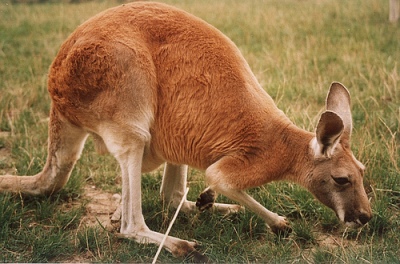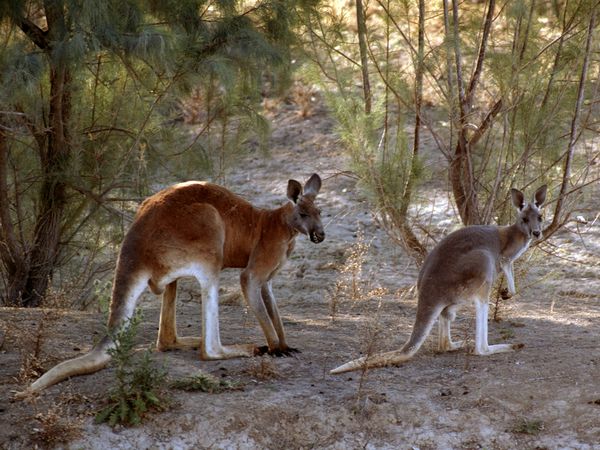Red Kangaroo (Macropus rufus)
Adaptation & Nutrition
A lot like camels, kangaroos have adapted quite well to their hot, dry, surroundings. They can manage a healthy living style by only taking in waters two times a week. Due to the savanna’s hot conditions you can find kangaroos hopping around in the early morning or late at night when it’s cooler, eating plants that provide much of their water and energy intake such as dewed grasses, and small shrubs(Giftlog 2012). Kangaroos have learned that moving around when they are not in direct sunlight means less sweat and it is much easier to conserve its scarce amount of energy and water(Kidcyber 2009). Red kangaroos have very strong digestive systems. They have tough, flat, molars, great for grinding and chewing on grass and vegetation(NatGeo 2013). Unlike most herbivores, the red kangaroo, does not loose teeth and grow new ones(NatGeo 2013). Instead, kangaroos teeth grow from the back of the mouth and move forward, shedding the front teeth out of the mouth and replacing the front with more sets of flat molars(NatGeo2013). Eventually the kangaroos learn to swallow more than chew, which is where a mutualistic relationship with bacteria is needed in the stomach of the kangaroo in order to break down the food consumed(Giftlog 2012). The bacteria and other decomposing organisms located in the stomach of the Red Kangaroo break down all of the food that the Kangaroo consumes and allows fermentation to occur due to the lack of oxygen in the Kangaroos stomach(Caughley, 1964). This allows for the Kangaroo to receive up to seventy percent of the foods energy that is consumed, which is higher than other herbivores, but much lower than us, omnivores(Giftlog 2012). There is no need for canine teeth in a kangaroo’s mouth because they feed only on shrubs and watery leaves. Instead, kangaroo’s have four rows of molars(Caughley, 1964). Because these teeth get worn down often from the dirt they chew when they graze on grass, the worn down teeth in the front simply fall out and a new row moves in(Kidcyber 2009).
Another adaption that Red Kangaroos have is their unique way of locomotion. The Red Kangaroo is one of very few animals that use hopping as its one and only way of moving around (Giftlog 2012). Hopping around may not seem like the most logical way to move around town, but for a kangaroo, evolution made it the easiest and most efficient (Dawson, 1973)! Unlike most of their distant relatives, the kangaroos have very strong hind legs, which allow them to jump comfortably(NatGeo 2013). A kangaroo has adapted feet and a long, large tail to help with their balance while hopping(Kidcyber 2009). The legs of Kangaroos are much stronger than those of other animals in their class. They have thicker bones and more elasticity in their ligaments and tendons giving their legs a similar effect of a trampoline. The harder you push down, the higher and farther you jump. Red Kangaroos have been seen jumping roughly 25 feet at times while hopping about, reaching speeds up to 35 miles per hour (NatGeo 2013)!
Let’s talk more about what they eat and how they can survive such harsh conditions on such little water supply. Kangaroos have three main ways to conserve water. One way is through estivation. Estivation is basically an organism sealing up their pores, and turning down their metabolism in a stretch to conserve energy and water(Springer-Verlag 1973). Camels are a prime example of an animal, other than kangaroos, that use estivation (also referred to as torpor) to survive the harsh conditions of the niche. The red kangaroo is mostly a dusk dweller, which means you won’t find many kangaroos hopping about and grazing during the day(Springer-Verlog 1973). They estivate in cool shadowy places, look after their young, and usually sleep. As soon as the weather cools down to a comfortable level, kangaroos will go out in search for water and food. They have adapted to much faster speeds compared to its relative- rodents, due to the fact that they must be able to flee from other dusk-dwellers who are carnivores such as the well-known Australian dingo, or the variety of foxes and wolves that roam the dessert conditions of the Australian Savanna(Giftlog 1996).
The second
adaption Red Kangaroos have is high urine concentration(Springer-Verlag
1973). Humans,
along with many other animals, lose a lot of water when we urinate. Due
to the fact water is precious in the savanna, marsupials have an evolved
bladder that concentrates pure urine and flushes the water content back
into the body. They also have a loop of Helen in the
nephrons of their
kidneys that allow for the reabsorption of water(Springer-Verlag 1973).
This is a constant process of pumping water from the urine back into the
veins near the legs and eventually spreads throughout the whole body
essentially leaving them hydrated off little or no water for a much
longer time than other animals in Australia(Springer-Verlag 1973).
The third adaption that the Red Kangaroo has is the ability to have dry feces. Kangaroos have nearly no water in their feces(Springer-Verlag 1973). They usually feast on vegetation and berries and whatever water they get from the food gets pumped back into the blood as soon as it reaches the kidneys. This basically means the only thing coming from a kangaroo’s rectum are digested stick and seeds. These three main ways are what keep Kangaroos hydrated and comfortable living in the harsh conditions of the Australian outback(NatGeo 2013).
Kangaroos adapt well even when pregnant(Kidcyber 2009). A female Red Kangaroo is known to be pregnant most of its adult life. The fetus itself is only in a kangaroo for about 30-35 days but stays in the pouch for over 9 months(Kidcyber 2009). The mother kangaroo has the ability to “freeze” the process in harsh environments such as droughts and then continue the reproductive process once it feels there are enough nutrients for both her and her young. Joeys spend most of their time in the mothers pouch until they are capable of keeping up with their mothers(Caughley, 1964).. The female kangaroo can have more than one Joey in her pouch at a time and is also capable to producing more that one concentration of milk at a time for more than one Joey(Giftlog 1996). Since kangaroos are only technically pregnant for 30 or so days before they are able to have sex again. Kangaroos are in a constant state of pregnancy(Kidcyber 2009). But unlike humans, female Red Kangaroos have to carry one or two kangaroos at a time in her pouch while trying to get enough nutrients and water to support her milk and be able to outrun predators at night(Springer-Verlog 1973). It’s a hard life for a Kangaroo!
The Red Kangaroo has a few more adaption's other than
speed to flee from its deadly predators of the Australian outback. The
Red Kangaroo has extremely well adapted ears capable of moving around on
its own to find out where sounds are coming from, similar to that of a
cat(Springer-Verlog 1973).
Their ears are constantly twitching, even when sound asleep and if
something sounds closer than what a kangaroo would like to hear it will
alertly get up and move (NatGeo 2013). There are many adaption's the Red Kangaroo has
to survive in the Australian Outback, and those adaption's do make
changes on how and what these animals eat.
To return to Home Page click here

